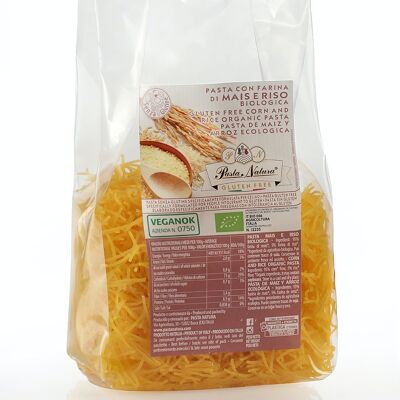


Oltresole organic white corn fusilli are a protein food suitable for those suffering from celiac disease and still want to enjoy a good plate of pasta produced with selected raw materials of the highest quality. Fusilli are produced with white corn, an ancient cereal which, unlike the classic corn, is poor in nickel and which favors the sense of satiety. Oltresole gluten-free pasta is produced in Italy from organic crops and still today the artisan processing is used, which involves slow drying at low temperature and bronze drawing. White corn is a cereal that contains many nutrients: vitamin A and vitamins of group B (vitamin B1 B2 B3) and some mineral salts (magnesium calcium and phosphorus iron potassium) which make it perfect for those looking for tasty but also nutritious foods and genuine. Oltresole organic pasta is highly digestible, low in fat and with a unique flavor, ideal for recipes with simple vegetable-based sauces. All Oltresole gluten-free pastas are free of preservatives and additives to keep the flavor, aroma and organoleptic properties of the raw materials unaltered. The corn flour pasta is available in the 350 gram package and is also suitable for those who are vegan or vegetarian. PAIRING: They go well with any type of sauce from the strongest to the most delicate flavors. Try a seitan ragout. White corn fusilli are excellent with the addition of beet spirulina or turmeric. WELLNESS AND HEALTH: In addition to having numerous beneficial properties for the body, white corn paste has a medium glycemic index and for this reason it can also be eaten in the evening. This food is also highly digestible thanks to the quantity of starches and fibers. It does not swell, it does not create intestinal fermentation, on the contrary, it regulates the functionality of the intestine, it does not cause drowsiness after eating it and satisfies it with a lower quantity than wheat pasta, which makes it ideal for those who have to lose a few extra pounds. FUN FACT: imported into Italy after the discovery of America, this variety spread as a typical crop especially in Veneto (see white polenta), while from the postwar period onwards it was increasingly supplanted by yellow corn and commercially more advantageous hybrid seeds. However, thanks to the initiative of some connoisseurs, we can still find white corn whose cob is thin and tapered with small grains.




























